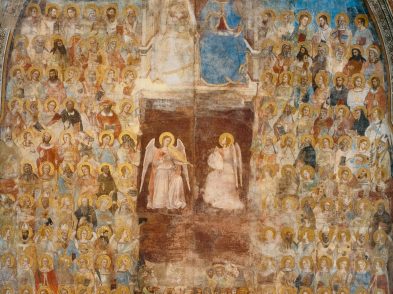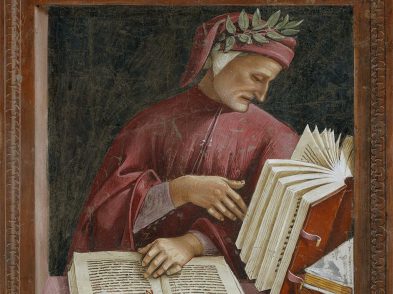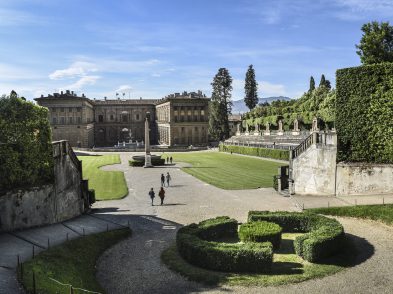Entering the Tribune in the 1580s, visitors must have felt as if they had been dropped into a giant treasure chest that had opened suddenly and surprisingly just for their benefit. The sumptuous octagonal room located in the Uffizi’s eastern corridor was topped by a cupola with golden ribs and encrusted with mother-of-pearl shells; the walls, covered in crimson silk, were punctuated by eight windows with an ultramarine, grotto-like background featuring still more mother of pearl deposits; and a playful frieze by masterful court painter Jacopo Ligozzi, featuring fish, birds, water, plants and rocks surrounded the circumference of the room.
Among the 30 paintings on display-the best of the Medici collection-were seven masterpieces by Raphael and nine by Andrea del Sarto. Precious marble inlay covered the floors and, at eye level was a shelf, divided in six places , holding a set of bronze statues depicting ancient gods. Small bronze statuettes, vases and figurines filled other shelves and niches. A specially created chest with 130 drawers was bursting with treasures, including coins, knives and other objects covered in precious metals and stones. The gilded walnut shelves of secret closets, built into two of the walls and hidden by thick crimson sheaths, held precious crystal vases.
The room was thick with symbolism: each object, each decoration was to be interpreted according to a strict symbolic code that would have been clear to those familiar with astrology, cosmology and numerology. The fusion of art, history and science that would characterize the Medici legacy was well underway in the Tribune, which was, in essence, an allegory of Medici power-a hymn to the virtue and strength of the prince.
Perhaps it was because of its messages and its design, so rooted in the late-sixteenth-century idea of the Wunderkammern-an almost-secret ‘room of wonders’ that catered exclusively to the prince and his fancies-that the Tribune’s interior was so altered over time.
As the centuries passed and tastes changed, modifications ‘modernized’ the room’s décor, some of which included the destruction of parts of the wall decoration (only one tiny fish remains from Ligozzi’s mural). Paintings and statues were rotated in and out according to aesthetic and cultural preferences of the time.
During the seventeenth and eighteenth centuries, the Tribune was a mandatory stop for foreign visitors, and there are numerous written and pictorial testimonies of what they saw. The room continuously retained its function as a venue for prestigious works, and at one time or another masterpieces such as Michelangelo’s Doni Tondo, Raphael’s Madonna della Seggiola and Titian’s Venus of Urbino have been displayed there.
Among the most important additions were the ancient statues, including the Arrotino, the Wrestlers and the Medici Venus, all brought to Florence from the Medici Villa in Rome by Cosimo III and placed in the Tribune in 1677.
During the era of the Grand Tour, it was the statues, not the paintings, that were central to the Tribune’s prestige, so much so that the room was referred to simply as ‘La Venere’ thanks to the presence of the Medici Venus, a second-century BCE Greek marble reworking of an earlier bronze (now lost). The statue became the centerpiece of the Uffizi collection and visitors enthusiastically commented on its incredible grace and beauty as they returned home. In one commentary, the Marquis de Sade is said to have been overcome by ‘sweet and holy emotions’ while viewing the sensual representation of the goddess of beauty and love as she attempts to hide her breasts and pubic region from the viewer, a gesture that many believe only increases her erotic appeal.
By the late twentieth century, Uffizi director Luciano Berti decided to reorder the room yet again, though major reorganization and restoration would have to wait. After all, the Friends of Florence had yet to be created.
RESTORATION
Uffizi director Antonio Natali has taken to calling the 2012 restoration of the Tribune ‘epic.’ Whenever the decision is made to intervene in the Uffizi it is a historic act, but for Natali this was a restoration and reordering that spoke to the heart, both his and that of the gallery: ‘Without a doubt, this is the project I have cared most for during my tenure as director. We have made new discoveries about the works and about the materials used to create this sacred space.’
The $1.1 million project included the full restoration of the entire Tribune, from the precious marble inlay floor to the top of the cupola’s lantern. Six thousand shells were restored; crimson silk cloth was recreated in the exact color thanks to an attentive study of historical documents and was rewoven using traditional methods; all of the ancient statues were cleaned and restored. In keeping with modern methods, all of the restoration is reversible and the process was meticulously documented to facilitate matters in the future when tastes or techniques will undoubtedly change.
Laura Lucioli was the restoration expert in charge of all decorative portions of the walls, cupola and lantern. For her, one of the highlights of working on the Tribune was the process prior to restoration when, in order to recreate the entire atmosphere of the room, they conducted an intensive scientific examination and found that not only were the materials rare and precious but the technique was also highly unusual. Lucioli and her team studied and then followed the traditional techniques closely in order to render the restoration as seamless as possible.
One of the most surprising discoveries during the restoration concerned the Medici Venus. Restorers found traces of gold and red color and tiny holes in her ears, confirming seventeenth-century travelers’ accounts of a Venus with golden hair, ruby red lips and dangling earrings. The color was likely scrubbed off during the cleaning the statue received after being returned to Florence from France, where it had been taken by Napoleon in the early 1800s. Fabrizio Paolucci, director of the Department of Classical Antiquities of the Uffizi, was especially pleased with the opportunity to reorder the room in a way that brought the importance back to the ancient sculptures in the Tribune. Scientific analysis also allowed experts to study the kind of marble used, which was often rare and extraordinarily precious.
One of the most significant decisions undertaken during the restoration was to prohibit entrance into the Tribune by sealing the room’s three entries. According to Natali, this move allows for the recovery of the intimacy and the ‘sacredness’ of the space. ‘Now people lower their voices when they approach the Tribune; it is almost like the altar of a church: the faithful can get near it but they cannot access it entirely.’
Thanks to the Friends of Florence (www.friendsofflorence.org), their donors and their organization, the sacred space in the heart of the Uffizi has regained its noble glory.
Join us on Saturday, February 16, at 11am for a visit to the Tribune and the Niobe Room, both restored by the Friends of Florence. Marble restoration expert Louis Pierelli will explain the techniques used in the restorations and provide special insight into working firsthand with ancient statuary. Contact Alexandra Lawrence at a.lawrence@theflorentine.net for reservations.








